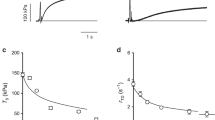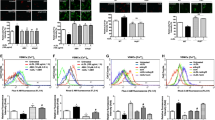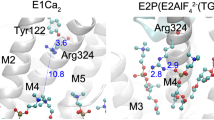Abstract
THE increase in calcium concentration which causes contraction of myofilaments may result from increased cellular permeability to extracellular calcium and/or translocation from cellular binding sites1. We have now demonstrated that the interaction of angiotensin with specific receptors in smooth muscle cell microsomes increases the release of membrane-incorporated calcium, in support of the translocation theory. Microsomes were prepared from adventitia-free rabbit aortae in 0.32 M sucrose–0.01 M Tris maleate, pH 7.4, by differential centri-fugations between 5,000 and 102,000g according to Verity and Bevan2. The vesicular nature of the 102,000g fraction was established by electron microscopy. No cytochrome c oxidase activity3 was detected, thus demonstrating the absence of mitochondrial contamination. Calcium binding by these isolated vesicles was studied in incubation mixtures containing 100 mM KCl, 5 mM MgCl2, and 10 mM histidine buffer (pH 6.8), with various concentrations of CaCl2 (containing 0.6 × 10−3 µCi ml.−1 45Ca), in 0.5 ml. Vesicular protein concentration4 was 50–100 µg ml.−1. The reaction, carried out at 26° C, was stopped by filtration through a ‘Millipore’ filter (HA, 0.45 µm) followed by quick rinsing with 5 ml. of chilled calcium-free medium, and the amount of calcium retained by the membrane fragments measured by counting filters after dissolution in ‘Cellosolve’ in a liquid scintillation spectrometer. Calcium binding in vesicles reached equilibrium after 10 min. The addition of 5 mM ATP to the incubation medium increased the binding 4-fold. Direct measurements of calcium-stimulated ATPase showed that activation of this enzyme was associated with calcium binding (Table 1). Oxalate at a concentration of 2.5 mM increased the calcium uptake about ten-fold; this potentiating effect, also observed on microsomal vesicles of skeletal, cardiac and uterine muscle5–8, is explained on the basis of its ability to permit trapping of calcium within the microsomes in the form of insoluble calcium oxalate. In the presence of ATP and absence of oxalate, calcium binding was saturated at a calcium concentration of 10−4 M in the medium. The calcium binding capacity was 6.5 pmol µg−1 protein. Sodium azide, known to inhibit calcium uptake in mitochondria9, had no effect on calcium binding by microsomes at a concentration of 0.5 mM. The release of membrane-incorporated calcium was studied after loading vesicles with 10−4 M Ca for 10 min. The incubation medium was then diluted by the addition of 25 volumes of calcium-free medium and the amount of calcium remaining in the vesicles was determined at various intervals by the filtration technique. Half the incorporated calcium was released into the medium within 1 min. The addition of ATP to the medium increased the rate of release. Angiotensin II increasingly affected calcium release both in the presence and absence of ATP to a significant degree within the first 2 min (Fig. 1). After 5 min, the amount of bound calcium remained constant up to 30 min and identical in the absence and in the presence of angiotensin. This result suggests that in the experimental conditions used, only about 60% of bound calcium was rapidly released, and that angiotensin was only acting on this fraction. When the concentration of angiotensin II in the medium was greater than 10−7 M, the releasing effect of angiotensin reached a maximum corresponding to a 25% increase in the rate of release occurring in its absence (Fig. 2).
This is a preview of subscription content, access via your institution
Access options
Subscribe to this journal
Receive 51 print issues and online access
$199.00 per year
only $3.90 per issue
Buy this article
- Purchase on Springer Link
- Instant access to full article PDF
Prices may be subject to local taxes which are calculated during checkout
Similar content being viewed by others
References
Somlyo, A. P., and Somlyo, A. V., Pharmacol. Rev., 20, 197 (1968).
Verity, A., and Bevan, J. A., Biochem. Pharmacol., 18, 327 (1969).
Cooperstein, S. J., and Lazarov, A., J. Biol. Chem., 189, 665 (1951).
Lowry, O. H., Rosebrough, N. J., Farr, A. L., and Randall, J. R., J. Biol. Chem., 193, 265 (1951).
Ebashi, S., J. Biochem., Tokyo, 50, 236 (1961).
Hasselbach, W., and Makinose, M., Biochem. Z., 333, 518 (1961).
Katz, A. E., and Repke, D. I., Circulation Res., 21, 153 (1967).
Carsten, M. A., J. Gen. Physiol., 53, 414 (1969).
Farnburg, B., and Gergely, J., J. Biol. Chem., 240, 272 (1965).
Morgat, J.-L., and Lam Thanh, Hung, and Fromageot, P., Biochim. Biophys. Acta, 207, 374 (1970).
Herbert, V., Kam-Seng, Lan, Gottlieb, C. W., and Bleicher, S. J., J. Clin. Endocrinol., 25, 1375 (1965).
Baudouin, M., Meyer, P., and Worcel, M., Biochem. Biophys. Res. Commun., 42, 434 (1971).
Fermandjian, S., Morgat, J.-L., and Fromageot, P., Europ. J. Biochem. (in the press).
Swynghedaw, B., Bouveret, P., and Piguet, V., Ann. Biol. Clin., 28, 159 (1970).
Author information
Authors and Affiliations
Rights and permissions
About this article
Cite this article
BAUDOUIN, M., MEYER, P., FERMANDJIAN, S. et al. Calcium Release induced by Interaction of Angiotensin with its Receptors in Smooth Muscle Cell Microsomes. Nature 235, 336–338 (1972). https://doi.org/10.1038/235336a0
Received:
Revised:
Issue Date:
DOI: https://doi.org/10.1038/235336a0
This article is cited by
-
Maligant hypertension: The Brazilian experience
Kidney International (1984)
-
Uptake and efflux of calcium by canine coronary arteries and the action of adenosine
Basic Research in Cardiology (1984)
-
Angiotensinamide — A high-activity pressor agent
Pharmaceutical Chemistry Journal (1976)
-
Characterization of pharmacological receptors
Naunyn-Schmiedeberg's Archives of Pharmacology (1975)
-
Effects of temperature and inorganic ions on calcium accumulation in microsomes from intestinal smooth muscle
Molecular and Cellular Biochemistry (1975)
Comments
By submitting a comment you agree to abide by our Terms and Community Guidelines. If you find something abusive or that does not comply with our terms or guidelines please flag it as inappropriate.



